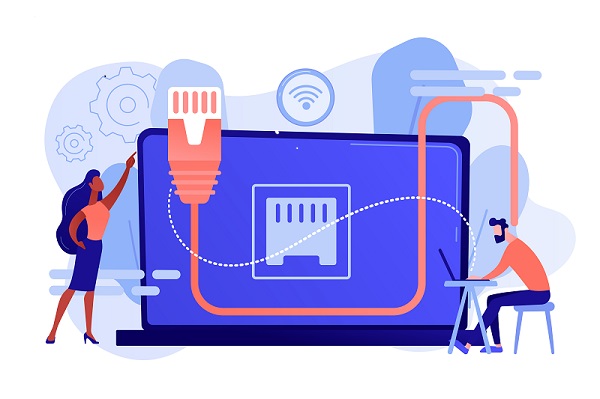What is Power Over Ethernet and the Benefits of Poe Lighting

Contents
Ethernet powered technology allows network cables to transmit power alongside data, enabling devices such as IP cameras, wireless access points, and lighting systems to be powered over a single Ethernet cable. In this guide, we will explore what is Power Over Ethernet and the advantages, providing a comprehensive overview of this innovative technology and its practical applications.
What Is Ethernet Powered Technology ?
Ethernet powered technology is a technology that allows electrical power to be sent over conventional Ethernet network lines. IP-based Lighting solutions have been widely used in data networking to power devices such as IP phones, security cameras, and wireless access points. PoE technology eliminates the need for these devices to have separate power supplies, making installation and maintenance easier and more cost-effective.
IP-based Lighting
Digital Lighting uses the same technology as data networking to supply power and Smart lighting systems. Instead of connecting separate electrical lines to power the lighting system, Network-powered LED lighting uses Ethernet cables to send both power and control signals.
Digital Lighting technology is suited for commercial and industrial situations where lighting management and control are critical for efficiency, productivity, and safety. It can also be utilized in the home as smart home automation.
Benefits of Ethernet-powered Lighting Technology
A network-powered lighting system is one that sends electrical power and data to light fixtures using a standard Ethernet wire. This cutting-edge technology offers numerous benefits, including:
- Energy Efficiency: Energy-efficient lighting can help reduce energy consumption by allowing users to control lighting levels, timing, and occupancy from a central control system. This can lead to significant energy savings and cost reductions.
- Simplified Installation: With IoT lighting technology, installation is simplified as a single Ethernet cable is used for both power and data transmission. This eliminates the need for additional electrical wiring, which can be expensive and time-consuming.
- Flexibility: Connected lighting systems are highly flexible and can be easily reconfigured and modified to meet changing lighting needs. The system can be programmed to change lighting levels automatically based on occupancy or time of day, creating a comfortable and energy-efficient environment.
- Scalability: Ethernet-enabled lighting solutions and technology can be easily scaled up or down depending on the size of the space or the lighting needs of the user. This makes them an ideal choice for both small and large commercial or residential applications.
- Improved Maintenance: Network-powered lighting can provide real-time monitoring of lighting fixtures, making it easier to identify and address any maintenance issues promptly. This can help reduce downtime and prolong the life of the lighting system.
- Integration with Other Building Systems: Network-powered lighting systems
can be integrated with other building systems, such as HVAC and security, to create a comprehensive building automation solution. This can improve overall efficiency and reduce energy consumption.
In summary, Network-powered LED lighting offers several benefits, including energy efficiency, simplified installation, flexibility, scalability, improved maintenance, and integration with other building systems. These benefits make it an attractive option for both commercial and residential lighting applications.
Examples Of Applications For Network-powered Lighting
Commercial buildings: IoT lighting solutions can be used in commercial facilities like offices, retail stores, and warehouses where lighting consumes a lot of energy. Building owners can minimize energy usage and maintenance expenses by employing Power-over-Ethernet lighting while also delivering a more flexible and responsive lighting system.
Smart homes: LED lighting systems can be integrated into smart homes, allowing homeowners to control their lighting remotely and set schedules for different rooms or areas of the house. This can also help homeowners reduce their energy consumption and lower their electricity bills.
Healthcare facilities: IoT Lighting solutions can be utilized in hospitals, clinics, and other healthcare institutions to create a dependable and energy-efficient lighting system. Intelligent lighting systems can be utilized to offer task lighting for medical procedures as well as ambient lighting for patient rooms and waiting spaces.
Outdoor lighting: IP-based lighting systems can be used in outdoor lighting applications such as street lighting, parking lots, and public spaces. By using Network-powered lighting technology, municipalities can reduce energy consumption, lower maintenance costs, and provide a more responsive and flexible lighting system.
Overall, Smart lighting technology is a versatile and energy-efficient technology that can be used in a wide range of applications.
How Does Network-powered Lighting Work?
Lighting solutions are a technology that allows lighting fixtures to receive both data and power through a standard Ethernet cable, eliminating the need for separate electrical wiring. PoE Lighting solutions use a network switch that can provide power to compatible LED lighting fixtures via the Ethernet cable, which also transmits data to and from the fixtures. This technology allows for greater flexibility and control over Digital PoE lighting solutions and technology, as well as increased energy efficiency and cost savings through centralized management and monitoring.
The Future of Network-powered Lighting Technology
Ethernet Lighting Solutions is a technology that allows power and data to be transmitted over Ethernet cables, enabling lighting fixtures to be powered and controlled through a single network cable. Network-powered LED lighting has already gained popularity in the commercial sector, where it has been used in office buildings, hospitals, and other large facilities. However, its adoption is expected to grow rapidly in the coming years due to several factors.
Energy-Efficient Lighting Solutions
One of the key drivers for the future scope of Network-powered LED lighting is the increasing demand for energy-efficient lighting solutions. Smart PoE Ambient lighting offers significant energy savings compared to traditional Lighting solutions, as it allows for more precise control of individual lights and reduces the need for separate power sources for each light. This not only results in cost savings for businesses but also reduces their carbon footprint.
Smart Building Technologies
Another factor that is expected to contribute to the future growth of Connected lighting technology is the increasing adoption of smart building technologies. Network-powered LED lighting is a key component of smart building systems, which enable buildings to be managed more efficiently and provide occupants with a more comfortable and productive environment. With the rise of the Internet of Things (IoT) and other connected technologies, PoE lighting is well-positioned to become an integral part of the smart building ecosystem.
Flexible and Adaptable Lighting Solutions
Finally, the increasing demand for flexible and adaptive Lighting solutions is anticipated to drive the future scope of Ethernet Lighting. Digital lighting systems provide greater design flexibility because they can be readily altered and customized to meet changing needs. This makes it a good choice for enterprises that need adaptable lighting solutions, such as retail outlets or conference centers.
In summary, the future scope of Connected lighting technology looks promising, with the technology expected to continue gaining popularity in the commercial sector and beyond. Its energy efficiency, integration with smart building technologies, and flexibility make it a compelling option for businesses looking to optimize their Lighting solutions and create more efficient and comfortable environments for their occupants.
Conclusion
Finally, power over Ethernet (PoE) lighting provides a highly efficient and cost-effective alternative to current Smart PoE lighting systems. Digital Lighting simplifies installation and maintenance by combining power and data transmission into a single Ethernet line, increasing flexibility, and improving control and automation possibilities. Network-powered LED lighting improves energy economy and user comfort by dynamically adjusting light levels and color temperatures. As a result, PoE lighting is gaining popularity in a variety of applications, such as business buildings, healthcare institutions, schools, and private houses. PoE lighting is poised to revolutionize the lighting sector as technology advances, paving the way for smarter and more sustainable lighting solutions.









